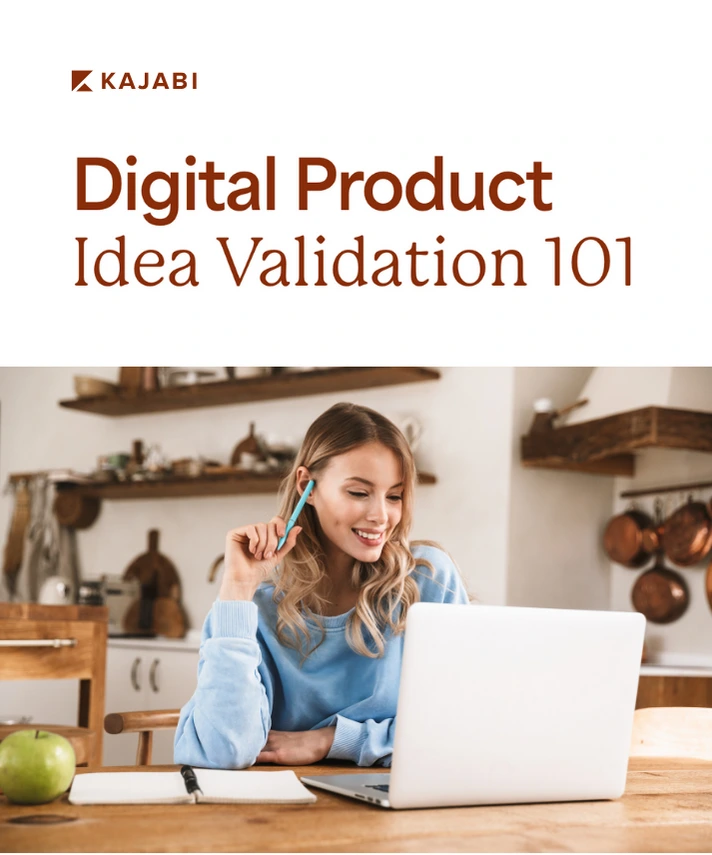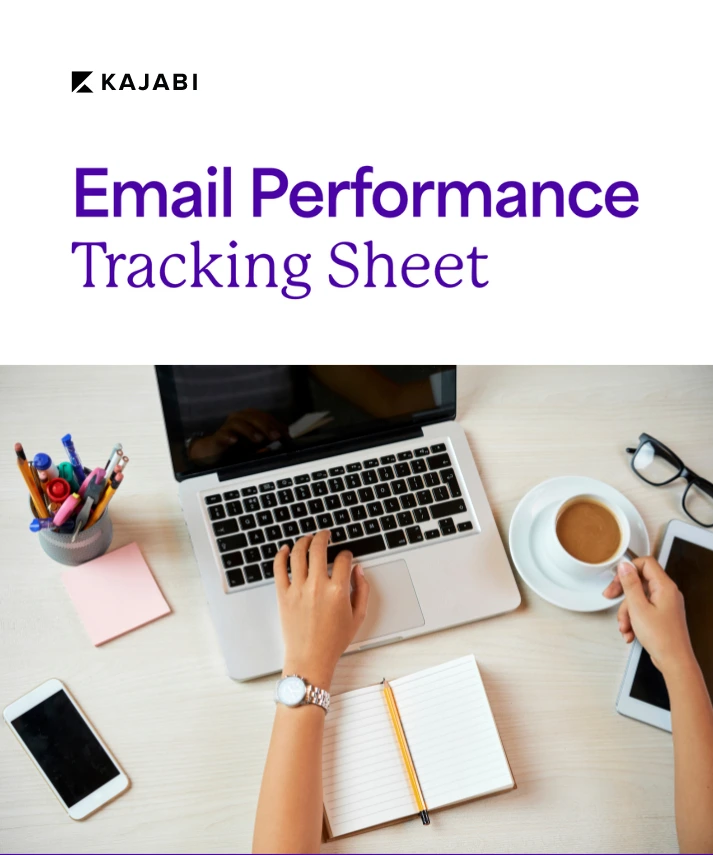
It's a bad idea to buy email lists - build yours instead
Get free expert insights and tips to grow your knowledge business sent right to your inbox.
An email list is a huge asset for any business. It’s your direct line to your customers and prospects.
However, all email lists are not created equal. Some lists can actually hurt your business more than help it, which is the issue we’re going to delve into today.
Email marketing can provide excellent ROI, but it should possess three essential qualities:
- Good leads
- Great Content
- Consistent Communication
If you can hit the trifecta of email marketing, you’ll quickly increase sales and grow your Knowledge Commerce business’s following.
It all starts with the list, though. Before you can create great content and consistently communicate with your subscribers, you need to know the best (and worst) ways to build the list in the first place.
One mistake that many entrepreneurs make is buying an email list. It’s a bad idea, so don’t be tempted. We’re going to explain what an email list is, why buying an email list is bad news, and how you can build your list organically.
What Is an Email List?

An email list is a list of email addresses obtained for the purpose of marketing. When Internet marketing first debuted, emails from businesses largely consisted of newsletters. However, the term “newsletter” has broadened significantly.
“You can send all different types of content to your email list, from persuasive sales emails to digital coupon codes. The important thing is to send something of value each and every time. #Kajabi” — Tweet this!
You can send all different types of content to your email list, from persuasive sales emails to digital coupon codes. The important thing is to send something of value each and every time.
New entrepreneurs often spam their email lists with junk email just to stay in contact. That’s a good way to convince your prospects to unsubscribe. Instead, you need to reach out only when you have something important to say.
That aside, growing your email list should remain a top priority for your business. You just have to go about it the right way.
Why Is Building an Email List Important?

Each time you email your prospects, you create another touchpoint on the timeline of your relationship with them. Even if they only glance at your email, your business’s name gets further cemented in each recipient’s mind.
It’s kind of like those billboards you see along the highway during your morning commute. They’re part of the background now, but you remember them because they catch your attention and you see them often.
Of course, email lists provide more value than that. Many people will actually open your emails, read them, and click on any links you include. Therein lies the real value.
We’ve talked a lot about converting prospects into customers, especially with regard to pipeline marketing. Conversions don’t take place in a vacuum, though. You have to ask for them.
Each email you send should include a CTA. You can ask people to sign up for your membership site, buy your online course, or otherwise become further enmeshed in your business. Each person who acts based on your CTA helps improve your conversion rate and contribute to sales.
How Can You Acquire an Email List for Your Business?

We know what an email list is now and why it’s important, but how do you get one? Well, there’s the easy way and the harder way.
You’re intrigued by the idea of an easy, fast email list, right? Everyone is. It sounds like a good deal because, after all, building a list organically takes time and effort. Why shouldn’t you find a shortcut?
The easy methods involve buying or renting an email list from someone else. The hard way is to build an email list organically.
Before you succumb to temptation, though, keep reading. You’ll want to know about the risks associated with the aforementioned shortcuts.
Let’s look at the three ways in which you can acquire an email list and whether they’re good for your business overall.
1. Buy an Email List
Lots of people and businesses sell email lists — sort of like they used to sell phone numbers and names back before email offered an easier way to contact people. You can find email lists of all sizes, from a few hundred addresses to several thousand.
These people make money because entrepreneurs like shortcuts. They want an easy way to reach as many people as possible.
However, buying an email list ignores one of the most important facets of email marketing. You don’t want to reach as many people as possible. You want to reach as many interested, qualified prospects as possible.
What’s the difference? Think about the products you sell on your Kajabi website. Maybe you sell online courses on public speaking for instance.
Your target market is people who are interested in becoming better public speakers. They want to build confidence, get ready for a speaking engagement, and learn oration skills.
That’s all great to know. But what if you buy an email list that consists of people who have no interest in public speaking? All those emails you send will prove worthless.
2. Rent an Email List
Think of email list rental as a form of sponsored mailing. Instead of buying a database or spreadsheet of email lists, you pay someone else (usually someone in your industry) to send your content to his or her email list.
You don’t actually get the email addresses, nor do you send those people content from your own email address. It’s kind of like paying to publish content on someone else’s site.
It sounds a lot less shifty than buying an email list — and it is. However, it’s definitely not ideal, especially when you consider the price tag.
For one thing, the cost to rent an email list will increase with several variables:
- Number of addresses on the host’s list
- Popularity and credibility of the host
- The host’s average response rate from email
Lots of other factors can come into play, too. Renting an email list can easily set you back several thousand dollars.
The other problem is that list rentals don’t perform as well as in-house lists. Why? Because the recipients are used to content from the host.
Imagine that you’re subscribed to a favorite industry expert’s email list. You love the sender’s voice, style, and content. Then, out of the blue, you receive an email from someone else entirely. It’s from the right email address, but the content’s completely foreign.
That’s a jarring experience. It can make subscribers resentful and irritated. Worse, it might cause them to avoid buying from your business in the future.
3. Own an Opt-in Email List
Now, we come to the last option. If you own your own opt-in email list, you control every aspect of it.
In other words, it belongs to you and you alone. You’ll know that the people on it actually want to hear from you and that they’re interested in your niche.
An opt-in email list consists of email addresses of people who have already encountered your business and want to hear more. Some might be customers, while others aren’t yet.
In other words, an owned, opt-in email list provides you with direct access to people who might actually buy your products. That’s pretty powerful.
It’s true that you’ll have to start from scratch. Unless you rent or buy an email list, that’s where everyone starts. However, with diligent effort, you’ll eventually acquire a healthy list consisting of qualified, interested leads.
Why does that matter? Because your ultimate goal with your list is to sell more products. If you’re sending emails to people who would never be interested in your products, you’re wasting your precious time.
Furthermore, you’re protecting your reputation — both personally and digitally (but we’ll get into that more later).
The best way to build an email list is to do so organically. It’s healthy for your business and for your subscribers. Plus, you won’t find yourself labeled as a spammer and you won’t alienate potential customers.
Why Shouldn’t You Buy an Email List?

We’ve covered a few reasons to avoid buying an email list, but we should go into more detail so you’re fully educated about the risks. After all, hurting your business with a bought list could eliminate your chances of developing healthy revenue.
We’ve come up with seven reasons to avoid buying email lists.
1. Lack of Control Over the Quality and Health of the List
When you buy email lists, you have no control over the contact information you receive. The seller might offer some vague demographics, but you still won’t know whether those people are interested in hearing from you.
A high-quality email list becomes a sizable asset. However, a low-quality list essentially turns your efforts into a waste of time.
When you grow your email list organically, you can choose how and when to attract subscribers. Consequently, the list becomes healthier and the quality improves. You also will know that, when you take the time to craft an email, people will actually appreciate your effort.
2. Inability to Reach People on the List Due to Email Providers’ Filters
Email providers’ filters have become increasingly effective. Gmail, in particular, is extremely adept at filtering out emails that recipients might not want to see.
For one thing, Gmail automatically filters emails into social and promotional folders. Some people don’t even check those folders because they don’t feel like getting sold to.
Worse, if your recipients’ email providers designate your emails as spam, nobody will ever see them at all. They’ll go directly into the spam folder, which many people automatically batch delete every day.
When your emails can’t reach the people on your list, they do no good whatsoever. Your ROI takes a steep decline, and you run the risk of getting your email address flagged permanently.
3. Lack of Recognition on the Part of People on the List
Have you ever received an email from someone you didn’t know? Did you delete it automatically?
That’s pretty common these days. We’re all too busy to waste time on emails that come from people we don’t know. Furthermore, risks like fishing tactics and viruses have made consumers wary about communications over the Internet.
If you buy an email list, the people on that list won’t recognize your email address, business name, or anything else about you. They’ll likely delete the email unread.
While this might not seem like a huge problem, it can hurt your reputation. People will know they didn’t sign up for your email list, so they’ll wonder why you’re sending them promotional messages.
4. Potential for Abandoned or Disused Email Addresses on the List
Nobody who sells an email list can guarantee that the addresses on the list are still in use. That’s impossible.
It’s true that you can’t control whether a legitimate subscriber has changed email addresses and not informed you. That’s a universal issue with email marketing.
However, you don’t want to start with a list that could prove 75 percent ineffective — or worse, 100 percent ineffective.
The goal with email marketing is to reach real people who are interested in your products or services. Period. When you buy email lists, you take that component out of the process.
5. High Probability for Poor Response Rates From Email Marketing
As an entrepreneur and marketer, you want every ounce of effort you put into your business to yield positive results. Those results could be a larger email list, higher profits, or an improved business reputation.
Buying email lists accomplishes none of those things. In fact, if you buy a list, you might not get any responses at all from your purchased audience.
Sure, you could acquire email addresses through legitimate means and still get no responses. That’s unlikely, but not impossible.
However, in that case, you didn’t spend any money to email those people. You sent out emails to people who signed up for your list through organic means.
In other words, if you buy an email list, you start out with negative ROI because you spend money up front. When you build your list organically, you can only break even in terms of dollars and cents.
6. Potential for IP Reputation Damage
Your IP (Internet protocol) is a specific number that identifies the address from which you send emails. It gets recorded whenever another email address receives one of your messages.
That’s pretty common knowledge. What you might not realize is that email providers track IP addresses. If your IP address gets associated with spam, the provider can start blocking your messages from everyone’s email addresses.
In other words, if you send a quick message to your mother about getting together for Thanksgiving, it might land in her spam folder or get deleted automatically. You don’t want to find yourself in that position.
When you buy email lists, you run the risk of getting flagged as a spammer by email providers. Your messages can get redirected without your knowledge, which might result in legitimate emails getting flagged as spam.
7. Looking Like a Spammer
Now, we come to one of the most important reasons for not buying email lists. Even if you don’t get flagged as a spammer by email providers, you could still look like a spammer in the eyes of the people who receive your messages.
Typically, consumers remember when they give their email addresses to others. They recall why they parted with that information, whether it was because they were considering making a purchase, interested in receiving coupons, or some other reason altogether.
The point here is that, when people don’t recognize you from a previous encounter, one word runs through their minds: spam.
It’s never good to associate your business with spam. You start to look like a charlatan who doesn’t care about your business’s reputation or ethics. And if you’re all about the sale — at any cost — people won’t want to buy from you.
It’s that simple.
How To Build Your Own Email List In 2021

We’ve made our position on buying email lists pretty clear. Don’t do it. But what should you do instead?
Building an opt-in email list is the best way to protect your business from the perils described above and to preserve your business’s identity and reputation. You just have to know how to do it correctly.
Use these nine steps to build your email list organically. Yes, it might take more time than renting or buying an email list, but you’ll thank yourself for your patience later.
1. Attract An Audience With Useful, Engaging Content
Let’s start with content. In fact, nearly all marketing starts there.
Without valuable, useful content, you’ll find it difficult to attract people to your website. Consumers use Google, Bing, and other search engines to find answers to their questions. If your website pops up as an answer, you might get a click.
Teach yourself basic SEO, research every subject you write about thoroughly, and produce long-form content that engages your audience and leaves them wanting more.
Even better, those people might want to further explore your knowledge by signing up for your email list. They’ll think, “Hey, this is great information. Maybe I can get more if I subscribe.”
That’s exactly the response you want.
2. Create a Lead Magnet
Sometimes, great content alone doesn’t attract email opt-ins. People often need an incentive to part with their contact information, and that’s where the lead magnet comes in.
A lead magnet is a piece of content, a tool, or some other item of value that you give away for free. You’ve likely responded to lead magnets before.
For instance, you might have subscribed to an email list to get an e-book, whitepaper, special calculator, or downloadable form for some specific purpose. The lead magnet was worth receiving emails from the business.
That’s the relationship you want to create. If you show you’re generous, people will be more willing to interact with you.
3. Add Highly Visible Opt-In Forms to Your Website
An opt-in form allows people to sign up for your email list. Ideally, it will only ask for two pieces of information:
- Name
- Email address
Many businesses don’t even bother with the name. They’d rather get the email address and skip the name so more people will sign up.
We’re all busy, so even a single extra form field can discourage us from signing up. We have too many things on our to-do lists to bother.
If you make your opt-in form highly visible on your website and keep it short, you’ll convince people to sign up. Keep the form above the fold on your website so people don’t have to scroll to see it.
4. Run Creative Email Marketing Campaigns
Many entrepreneurs focus too much on building an email list and not enough on nurturing it. Without a good email marketing campaign, your efforts will never yield a positive ROI.
Segment your list based on how people signed up, send regular promotions and educational materials, and pack every email full of value. If you impart wisdom free of charge, your subscribers will want to know more.
5. Consistently Prune Your List
As we covered in our screed against buying email lists, you don’t want a list filled with inactive or disinterested subscribers. One want to keep your email list healthy is to prune it every once in a while.
Send an email to people who haven’t interacted with your messages in several months. Ask whether they’re still interested in receiving emails from you.
If they’re not, they can conduct a one-click unsubscribe. That way, you don’t risk irritating them with your messages.
6. Encourage People to Forward Your Emails
Word of mouth doesn’t just work in person. It can also work via email.
Invite your subscribers to forward your emails to anyone who might find them useful. Those people might be intrigued by your content, click through to your website, and sign up themselves.
The point here is to avoid missing any opportunity to connect with people who might eventually become customers. If someone is interested in your business, he or she likely has friends, family members, and colleagues who would be interested, too.
7. Take Care to Avoid Spam Trigger Words
While it’s much safer to build an email list organically than to buy one, you can still wind up in the spam folder if you’re not careful. Email providers scan for “trigger words” that indicate a message contains spam.
Some of those words include the following:
- Free
- Never
- Consultation
- Risk free
- Act now
- Best price
- Unlimited
- Hello
- Only
It’s most important to avoid these words in your subject lines. You can use them sparingly in the email body, but only if they make sense in context.
8. Honor Requests for List Removal
If someone asks to be removed from your subscriber list, don’t hesitate to remove them. In fact, automatic unsubscription options are extremely useful for any email marketing campaign.
Sure, it hurts when someone decides to unsubscribe. But the request indicates the person is no longer interested in what you offer. Why would you want to pester someone who won’t ever become a customer?
Instead of taking it personally, simply honor the request and continue to collect more email addresses.
9. Use an Authentication Process
When people sign up for your email list, you want to authenticate them as well as possible. For instance, you want to know that it isn’t a fake email address someone uses just to get a free lead magnet.
Use Kajabi’s built-in email marketing tools to authenticate subscribers. You’ll thank yourself for building a healthy list full of people who genuinely want to hear from you on a regular basis.
Use Kajabi To Turn Your Knowledge And Content Into Products You Can Sell

It’s easy to create your own email list with Kajabi. We have built-in tools that not only allow you to collect email addresses and send emails, but also to track your marketing plan’s success.
Conclusion
Email marketing is one of the most effective ways to build a relationship with your prospects. It’s also one of the most dangerous if you rent or buy your email list.
An email list should be a collection of email addresses from people who genuinely want to hear from you. In other words, they should sign up of their own accord.
Buying email lists can produce lots of risks, from getting labeled as a spammer to ruining your business’s reputation.
Fortunately, you can build your own email list in just a few easy steps. Create magnetic content, create a lead magnet, and add a visible opt-in form to your website. Run creative email marketing campaigns, prune that list, and encourage people to share the emails you send.
Make sure you don’t activate any spam triggers. If someone asks to unsubscribe, heed that request immediately. You can also use an authentication process to keep your email list as pure as possible.
Have you started curating an email list? What are your favorite strategies?
Build Your Email List With Kajabi
Join 50,000 other knowledge entrepreneurs growing their businesses online with Kajabi's all-in-one suite of tools. Get your free trial today!
Find more blog posts by category:




.jpeg)








